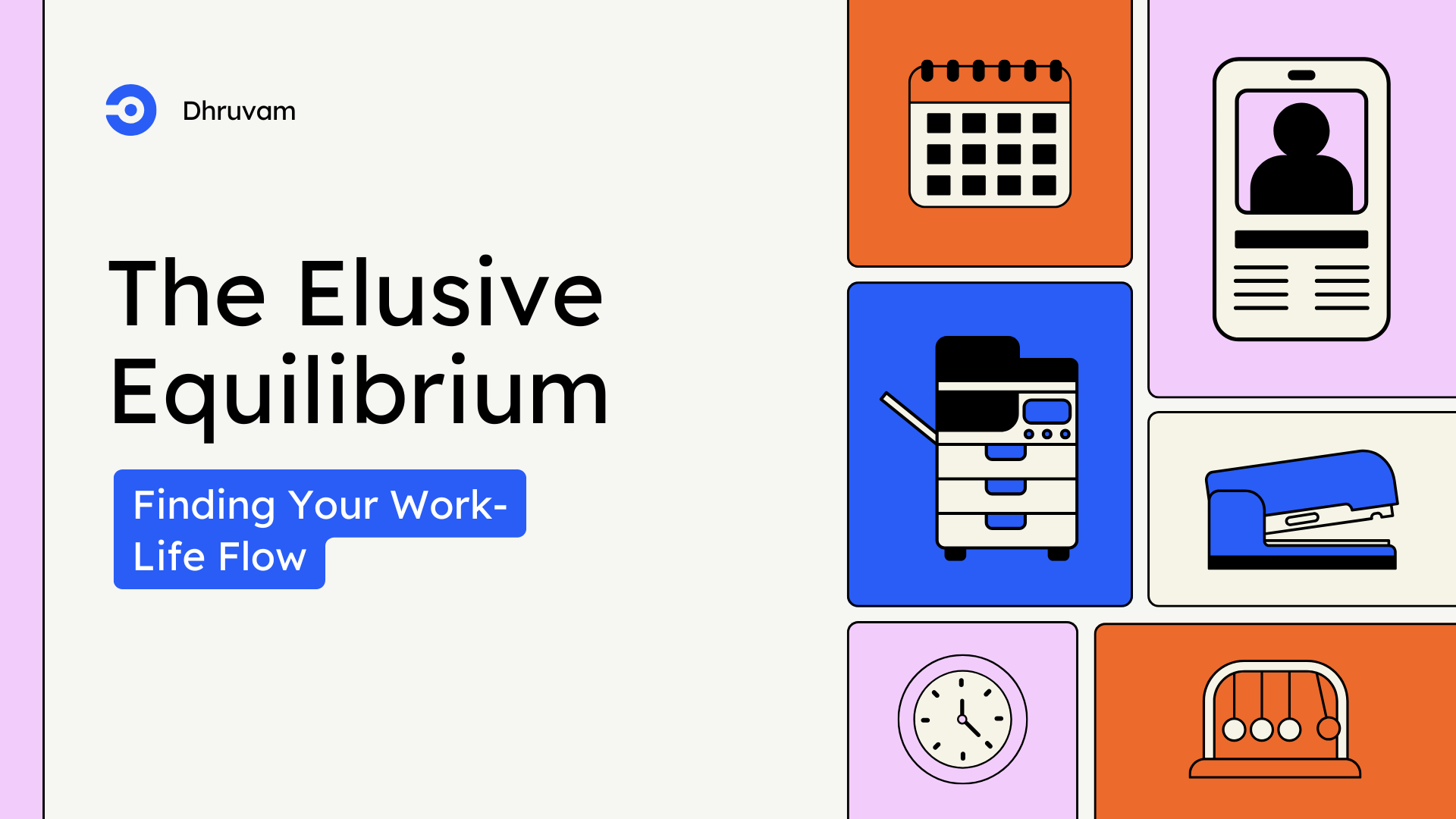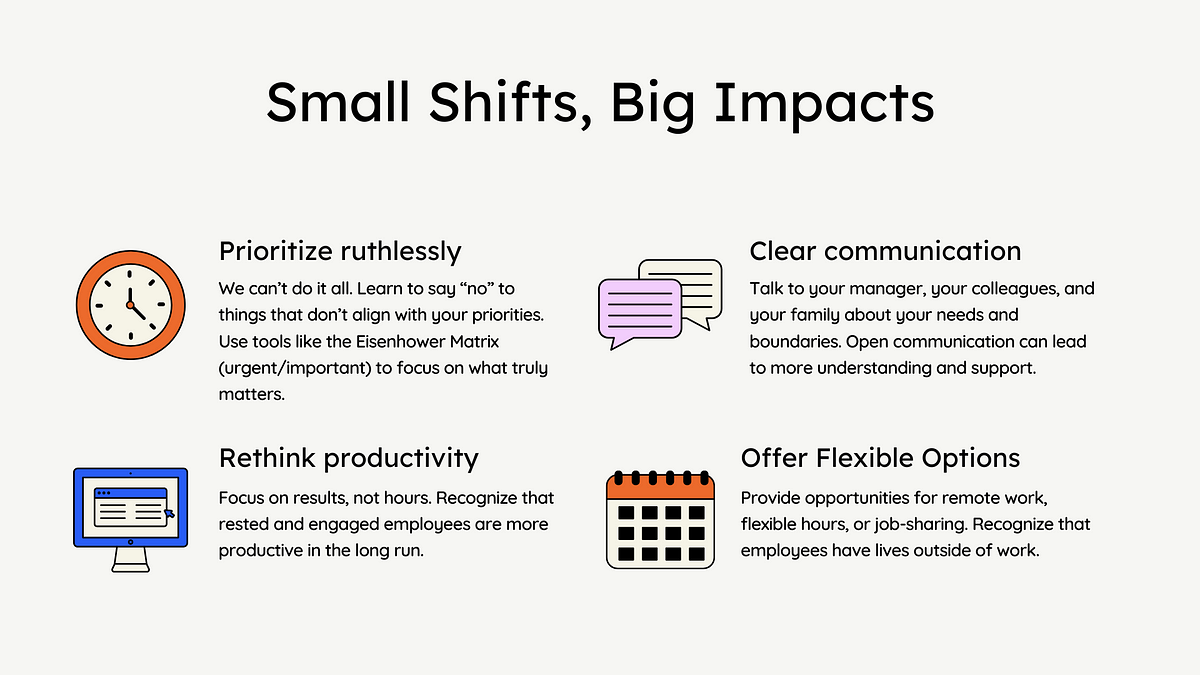The Elusive Equilibrium: Finding Your Work-Life Flow
“We’re totally guilty of doing too much at once, all while trying to manage the noise in our heads that says we’re not doing enough.” —…

“We’re totally guilty of doing too much at once, all while trying to manage the noise in our heads that says we’re not doing enough.” — Vanessa Autrey
Free link for readers
Remember that mythical creature, the unicorn? For many of us, “work-life balance” feels just as elusive. We’re juggling demanding careers, family, friends, and the ever-present buzz of technology. It’s a recipe for feeling stretched thin, constantly connected, and running on empty.
You know the feeling, right? That Sunday evening dread as the workweek looms, the constant checking of emails “just in case,” the guilt of missing out on family time because of a last-minute deadline. We’ve all been there.
The truth is, there’s no one-size-fits-all solution. Your “balance” will look different from mine and probably change throughout your life. A young professional climbing the corporate ladder might willingly embrace longer hours, viewing them as an investment in their future. Conversely, someone with a growing family or established priorities might crave more flexibility and dedicated personal time. The key lies not in a universal formula, but in a conscious and continuous effort to align our professional pursuits with our broader life values and needs.
It’s about finding your flow, that sweet spot where work energizes you without completely draining you, and where you have the time and energy for the people and passions that make your life rich and meaningful.
The Tech Trap: Our Digital Tightrope Walk
We can’t talk about work-life balance without talking about technology. Those tools that were supposed to make our lives easier — email, instant messaging, smartphones, and even those helpful AI assistants — have, in many ways, blurred the lines between “work” and “life” to an almost unrecognizable degree.
The workday doesn’t end at 5 pm anymore. It’s on our phones, in our inboxes, and buzzing at us on weekends. We’re always “on,” tethered to our devices, and that constant connectivity can leave us feeling drained, overwhelmed, and disconnected from the things that truly matter: our families, our friends, our hobbies, and, perhaps most importantly, ourselves.
Think about it:
- How many times have you checked your email while at dinner with loved ones?
- How often do you find yourself scrolling through work-related messages on a Sunday afternoon?
- Do you ever truly disconnect, or is there always a part of your mind still “at the office?”
This digital tightrope walk has become the new normal for many of us, and it’s taking a toll.
And let’s be real, society and workplace culture often don’t help. We’re praised for being busy, and long hours can be seen as a badge of honor, a sign of dedication and commitment. This pressure to keep up, to be seen as “always on,” can lead to burnout, sacrificing our well-being for the sake of our careers. We fear missing out on opportunities, or being perceived as less dedicated, and this fear can drive us to sacrifice our time, our health, and our happiness.
The High Cost of Imbalance
“I wish I had treasured the doing a little more and the getting it done a little less.” — Anna Quindlen
The irony is that this relentless pursuit of productivity often backfires. Studies have shown that chronic overwork and stress lead to:
- Decreased productivity: Exhausted and stressed employees are less focused, less creative, and more prone to errors.
- Increased health risks: Long hours and constant stress can contribute to a range of health problems, including heart disease, depression, and anxiety.
- Damaged relationships: When work consumes all our time and energy, our relationships with family and friends suffer.
- Burnout: That feeling of being completely depleted, both physically and emotionally, is a serious consequence of long-term imbalance.
We’re starting to realize that overworked and stressed-out people aren’t productive or happy. Companies are beginning to prioritize employee well-being, and we’re having more open conversations about the importance of balance.
Small Shifts, Big Impact: Reclaiming Our Time and Energy

The good news is, the tide is turning. We’re starting to realize that overworked and stressed-out people aren’t productive or happy. Companies are beginning to prioritize employee well-being, and we’re having more open conversations about the importance of balance.
Here are some things we can do, both as individuals and within our workplaces, to move towards a healthier flow:
For ourselves:
- Set boundaries: This is non-negotiable. Create clear lines between work and personal time. Turn off those notifications, set specific “off-hours,” and protect your time for family, hobbies, and downtime.
- Prioritize ruthlessly: We can’t do it all. Learn to say “no” to things that don’t align with your priorities. Use tools like the Eisenhower Matrix (urgent/important) to focus on what truly matters.
- Delegate and ask for help: At work, delegate tasks when you can. At home, don’t be afraid to ask for support from your partner, family, or friends. You don’t have to carry the weight of the world on your shoulders.
- Be mindful of tech: Use technology intentionally. Don’t let it control you. Schedule specific times to check email, and resist the urge to constantly scroll.
- Practice self-care: This isn’t a luxury; it’s a necessity. Make time for activities that nourish your mind, body, and soul. Exercise, hobbies, nature, meditation — whatever helps you recharge.
- Communicate: Talk to your manager, your colleagues, and your family about your needs and boundaries. Open communication can lead to more understanding and support.
- Embrace flexibility: If possible, explore flexible work arrangements like remote work or flexible hours. This can give you more control over your schedule and help you better integrate work and life.
For our workplaces:
- Create a culture of balance: Encourage employees to take breaks, use their vacation time, and disconnect after hours. Lead by example, and don’t glorify overwork.
- Offer flexible options: Provide opportunities for remote work, flexible hours, or job-sharing. Recognize that employees have lives outside of work.
- Invest in well-being: Offer resources and support for employees’ physical and mental health, such as wellness programs, mental health days, or on-site fitness facilities.
- Rethink productivity: Focus on results, not hours. Recognize that rested and engaged employees are more productive in the long run.
AI: Friend or Foe?
Ironically, the same AI tools that can contribute to our always-on culture, blurring the lines between work and life, can also be leveraged to help us reclaim some of that balance.
AI has the potential to be a powerful ally in our quest for a more balanced existence. It can automate mundane and repetitive tasks, summarize information, and streamline our schedules, freeing up time for more meaningful work and personal pursuits.
For example:
- AI-powered email tools can help us process our inboxes more efficiently, filtering out the noise and prioritizing important messages, reducing the time we spend on email management.
- AI assistants can help us schedule meetings, manage our calendars, and even draft initial responses, streamlining administrative tasks and freeing up our time for more focused work.
- AI tools for project management can help teams collaborate more effectively, track progress, and identify potential roadblocks, reducing the need for lengthy meetings and after-hours work.
However, and this is crucial, we need to be mindful of how we use these tools. If we’re not careful, AI can exacerbate the problem, further entrenching us in a culture of constant connectivity and the expectation of instant responses.
The key is to leverage AI as a tool for efficiency and time management, not as a means to further blur the boundaries between work and life. We need to use AI to create more space for ourselves, not to fill that space with more work.
The Journey, Not the Destination
Work-life balance isn’t a destination we reach; it’s an ongoing journey. Our priorities shift, our needs change, and we’ll constantly need to readjust. The key is to be intentional, to listen to ourselves, and to make choices that align with our values.
Let’s ditch the myth of the perfect balance and embrace the reality of finding our flow — a way of working and living that energizes us, fulfills us, and allows us to thrive both professionally and personally.
“The key is not to prioritize what’s on your schedule, but to schedule your priorities.” — Stephen Covey
